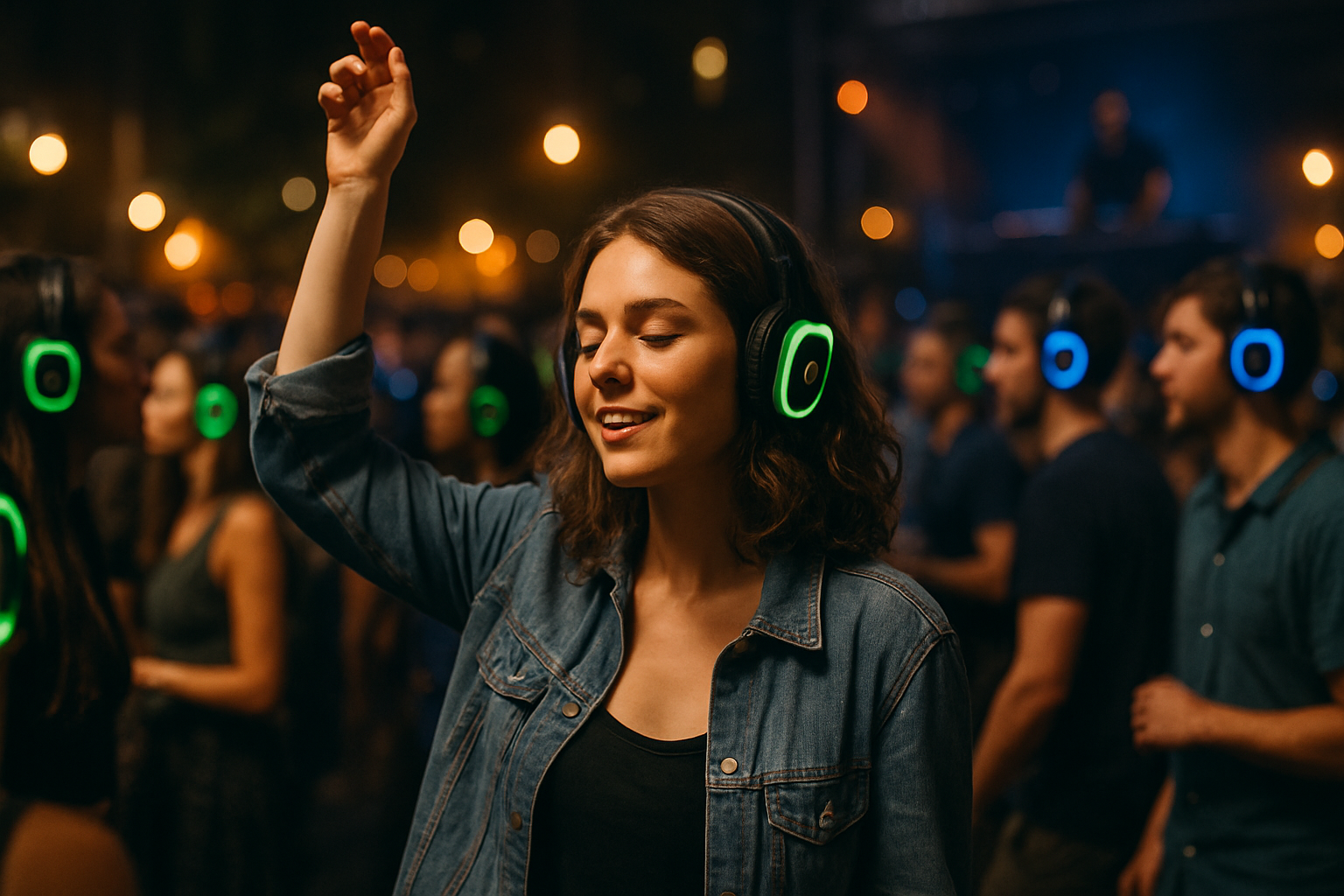Sonic Sanctuaries: The Rise of Silent Discos in Urban Spaces
The pulsating beats of music fill the air, yet the streets remain eerily quiet. Bodies move in synchrony, lost in their own worlds, while passersby look on in confusion. This is the scene at a silent disco, a phenomenon rapidly gaining popularity in urban centers worldwide. As cities grapple with noise pollution and evolving social norms, silent discos offer a unique solution to communal celebration. Read below to explore how this innovative approach to nightlife is reshaping our urban soundscapes and social interactions.

The origins of silent discos can be traced back to eco-activists in Finland, who used the technology to host outdoor parties without disturbing wildlife. As the concept spread, it found new applications in urban settings, where noise restrictions and neighborly considerations often limit traditional nightlife options. The silent disco format offered a creative workaround, allowing revelers to party into the early hours without infringing on local noise ordinances.
Technological Advancements Fueling the Trend
The proliferation of silent discos owes much to advancements in wireless technology and audio equipment. Early iterations of silent disco headphones were bulky and limited in range, but modern systems boast impressive sound quality and extended battery life. Multi-channel headphones now allow participants to switch between different DJs or music genres at will, creating a more personalized and interactive experience.
Additionally, the integration of LED lighting into headphones has added a visual dimension to silent discos. These lights often change color based on the channel selected, creating a mesmerizing sea of colors that adds to the spectacle for both participants and onlookers. This visual component has made silent discos increasingly popular for outdoor events and festivals, where they serve as both entertainment and public art installations.
Social Dynamics in a Soundless Setting
Silent discos present a fascinating study in human behavior and social interaction. Without the shared auditory experience of traditional nightclubs, participants must rely more heavily on visual cues and body language to connect with others. This dynamic creates a unique social atmosphere, where dancers can be fully immersed in their own musical world while simultaneously engaging with those around them.
Sociologists have noted that silent discos often foster a more inclusive environment than traditional nightclubs. The ability to control one’s own volume and switch between music channels reduces sensory overload, making these events more accessible to individuals with auditory sensitivities or those who simply prefer a quieter nightlife experience. Furthermore, the novelty of the silent disco format often breaks down social barriers, encouraging interactions between strangers who might otherwise not connect in a conventional club setting.
Urban Planning and Public Space Utilization
The rise of silent discos has caught the attention of urban planners and city officials seeking innovative ways to revitalize public spaces. Parks, rooftops, and even abandoned buildings have been transformed into temporary dance floors, breathing new life into underutilized areas. This flexibility in location has allowed cities to host cultural events in spaces that would typically be off-limits due to noise concerns.
Moreover, silent discos have proven to be an effective tool for community engagement and place-making. By bringing people together in shared experiences without disrupting the surrounding environment, these events foster a sense of community while respecting the needs of non-participants. This balance has made silent discos particularly popular in densely populated urban areas, where the competing interests of nightlife enthusiasts and residents seeking peace and quiet often clash.
Environmental and Health Considerations
From an environmental perspective, silent discos offer several advantages over traditional outdoor music events. By eliminating the need for large speaker systems, they significantly reduce energy consumption and carbon footprint. The localized nature of the audio also minimizes sound pollution, which can have detrimental effects on urban wildlife and ecosystem health.
Health professionals have also taken note of the potential benefits of silent discos. The ability to control individual volume levels allows participants to protect their hearing, addressing a growing concern about noise-induced hearing loss among young people who frequent loud nightclubs. Additionally, the physical activity involved in dancing, combined with the reduced stress of a quieter environment, may offer cardiovascular and mental health benefits.
The Future of Urban Nightlife
As cities continue to evolve and adapt to changing social norms and environmental concerns, silent discos represent a promising model for the future of urban nightlife. Their ability to balance the desire for communal celebration with the need for urban tranquility makes them an attractive option for both event organizers and city planners. While they are unlikely to completely replace traditional nightclubs and music venues, silent discos offer a complementary form of entertainment that expands the possibilities for nocturnal urban experiences.
The ongoing development of virtual and augmented reality technologies may further transform the silent disco concept, allowing for even more immersive and interactive experiences. As we move forward, the line between physical and digital spaces may blur, creating new opportunities for social connection and urban exploration through the medium of silent, shared music experiences.
In conclusion, silent discos exemplify the innovative spirit of modern urban culture, offering a creative solution to the age-old tension between nightlife and urban livability. As this trend continues to grow and evolve, it will undoubtedly play a significant role in shaping the soundscapes and social fabric of our cities for years to come.





